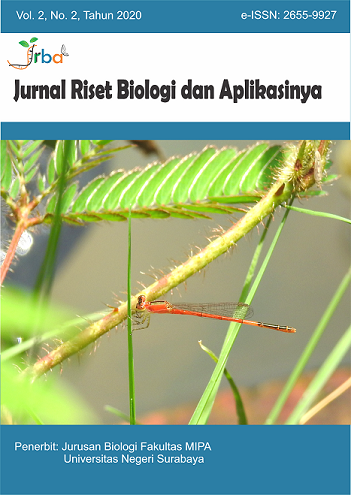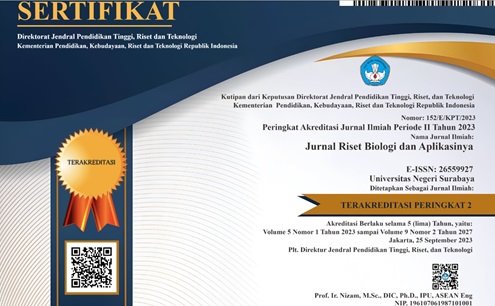Defining the Rearing Cage for Agriocnemis femina Damselfly (Odonata, Zygoptera, Coenagrionidae)
DOI:
https://doi.org/10.26740/jrba.v2n2.p42-48Keywords:
Agriocnemis femina, cage setup, feeding, ornamental plants, rearingAbstract
Rearing insects such as dragonflies and damselflies aim to gain uniform progeny that used for scientific purposes. In Indonesia, unfortunately, this rearing type is not yet common which suggests the time for its initiation. This study has objective to define the type of rearing cage for Agriocnemis femina damselfly (Odonata, Zygoptera, Coenagrionidae). It was conducted descriptively by using two smalls (9 x 13 x 23 cm), four medium (14 x 15 x 22 cm) and two larges (20 x 23 x 33 cm) size boxes as cage setups, with or without ornamental plants in it. The feeding was with limited (10-15 Drosophila flies provided per day) and unlimited provision. Data was analyzed descriptively. The results showed that A. femina lived normally, including eating and mating, within the large cage setup equipped with ornamental plants and unlimited feeding.
References
Bridges, C.B. (1933). Apparatus and Methods for Drosophila Culture. The American Naturalist 66 (704), 250-273. https://doi.org/10.1086/280430.
Bybee, S., Córdoba-Aguilar, A., Duryea, M. C., Futahashi, R., Hansson, B., Lorenzo-Carballa, M. O., Schilder, R., Stoks, R., Suvorov, A., Svensson, E. I., Swaegers, J., Takahashi, Y., Watts, P. C., & Wellenreuther, M. (2016). Odonata (dragonflies and damselflies) as a bridge between ecology and evolutionary genomics. Frontiers in Zoology, 13(1), 120. https://doi.org/10.1186/s12983-016-0176-7.
Carruthers, R.I., Larkin, T.S., Firstencel, H., & Feng, Z. (1992). Influence of Thermal Ecology on the Mycosis of a Rangeland Grasshopper. Ecology, 73(1), 190-204. https://www.jstor.org/stable/1938731
Carvalho, G. B., Kapahi, P., Anderson, D. J., & Benzer, S. (2006). Allocrine modulation of appetite by the sex peptide of Drosophila melanogaster. Current Biology, 16(7), 692696. https://doi.org/10.1016/j.cub.2006.02.064.Allocrine.
Chamber DL. (1977). Quality Control in Mass Rearing. Annual Review of Entomology, 22, 289-308. https://doi.org/10.1146/annurev.en.22.010177.001445
Cohen, A. C. (2018). Ecology of Insect Rearing Systems: A Mini-Review of Insect Rearing Papers from 1906-2017. Advances in Entomology, 06(02), 86115. https://doi.org/10.4236/ae.2018.62008
Córdoba-Aguilar, A. (2008). Dragonflies and Damselflies: Model Organisms for Ecological and Evolutionary Research. Dragonflies and Damselflies: Model Organisms for Ecological and Evolutionary Research, 94(3), 1304. https://doi.org/10.1093/acprof:oso/9780199230693.001.0001.
Corbet PS. (1999). Dragonflies, Behavior and Ecology of Odonata. New York: Cornell University Press.
Gossum, H.V., Rivera, A.C., & Sánchez. (2003). Observations on rearing damselflies under laboratory conditions. Animal Biology, 53(1),37:45. https://doi.org/10.1163/157075603769682567.
Hinks, C.F & Erlandson, M.A. (1994). Rearing Grasshoppers and Locusts: Review, Retionale and Update. Journal of Orthoptera Research, 3, 1-10. https://www.jstor.org/stable/3503403.
Janra MN, Gusman D, Susanto A, Yatap H, Fahrudin A, Andriansyah F, Prameswara A and Herwina H, (2020). Keanekaragaman Hayati KPHL Seluma Odonata. Bengkulu: Dinas Lingkungan Hidup dan Kehutanan Provinsi Bengkulu.
Locklin, J. L., Huckabee, J. S., & Gering, E. J. (2012). A method for rearing large quantities of the damselfly, Ischnura ramburii (odonata: Coenagrionidae), in the laboratory. Florida Entomologist, 95(2), 273277. https://doi.org/10.1653/024.095.0205.
McCullough, E. L., Verdeflor, L., Weinsztok, A., Wiles, J. R., & Dorus, S. (2020). Exploratory Activities for Understanding Evolutionary Relationships Depicted by Phylogenetic Trees: United but Diverse. The American Biology Teacher, 82(5), 333337. https://doi.org/10.1525/abt.2020.82.5.333.
Mazzacano, C., Paulson, D., & Abbott, J. (2014). Guidelines for Creating & Managing Habitat for Dragonflies & Damselflies. Portland, OR: Migratory Dragonfly Partnership.
Okude, G., Futahashi, R., Tanahashi, M., & Fukatsu, T. (2017). Laboratory Rearing System for Ischnura senegalensis (Insecta: Odonata) Enables Detailed Description of Larval Development and Morphogenesis in Dragonfly. Zoological Science, 34(5), 386397. https://doi.org/10.2108/zs170051.
Perry, J.C. (2011). Mating stimulates female feeding: testing the implications for the evolution of nuptial gifts. Journal of Evolutionary Biology, 24 (8), 17271736. 10.1111/j.1420-9101.2011.02299.x.
Rice, T. M. (2008). A review of methods for maintaining odonate larvae in the laboratory, with a description of a new technique. Odonatologica, 37(1), 4154.
Roe, A. D., Demidovich, M., & Dedes, J. (2018). Origins and History of Laboratory Insect Stocks in a Multispecies Insect Production Facility, with the Proposal of Standardized Nomenclature and Designation of Formal Standard Names. Journal of Insect Science, 18(3), 19. https://doi.org/10.1093/jisesa/iey037.
Setiyono J, Diniarsih S, Oscilata ENR and Budi NS. (2017). Dragonflies of Yogyakarta. Yogyakarta: Indonesian Dragonfly Society.
Silsby J, (2001). Dragonflies of the World. Washington DC: Smithsonian Institution Press.
Tilyard RJ. (1917). The Biology of Dragonflies. Cambridge University Press, United Kingdom.
Switzer, P. (2002). Using Dragonflies as Common, Flexible & Charismatic Subjects for Teaching the Scientific Process. The American Biology Teacher, 64(2), 158162. https://doi.org/10.1662/0002-7685(2007)69
Tsukamoto, Y., Kataoka, H., Nagasawa, H., & Nagata, S. (2014). Mating changes the female dietary preference in the two-spotted cricket, Gryllus bimaculatus. Frontiers in Physiology, 5, 16. https://doi.org/10.3389/fphys.2014.00095.
Downloads
Published
How to Cite
Issue
Section
 Abstract views: 1043
,
Abstract views: 1043
, PDF Downloads: 737
PDF Downloads: 737












